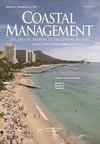There Is no I in EAFM Adapting Integrated Ecosystem Assessment for Mid-Atlantic Fisheries Management
IF 1.9
4区 环境科学与生态学
Q4 ENVIRONMENTAL SCIENCES
引用次数: 16
Abstract
Abstract Resource managers worldwide are being asked to consider the ecosystem while making management decisions. Integrated Ecosystem Assessment (IEA) provides a flexible framework for addressing ecosystem considerations in decision making. The US Mid-Atlantic Fishery Management Council (Council) adapted the IEA approach and implemented a structured decision framework to address species, fleet, habitat, and climate interactions as part of their Ecosystem Approach to Fisheries Management (EAFM) in 2016. The Council’s EAFM decision framework first uses risk assessment to prioritize fishery-ecosystem interactions for consideration. The Council’s 2017 EAFM risk assessment identified a range of ecological, social, and management objectives or risk elements. Development of a conceptual model to identify key environmental, ecological, social, economic, and management linkages for a high-priority fishery is the second step in the framework. The Council identified summer flounder (Paralichthys dentatus) as a high-risk fishery and finalized an EAFM conceptual model that considers high-risk factors and ecosystem elements in 2019. The Council used the conceptual model to identify three priority summer flounder management questions (recreational data uncertainty, recreational discards, and distribution shifts) to be considered for quantitative management strategy evaluation, the third step in the EAFM framework and set to begin in 2020. Finally, as strategies are implemented, outcomes are monitored and the process is adjusted, and/or other priorities identified in the risk assessment can be addressed. The Council’s rapid progress in implementing EAFM resulted from an extensive, positive, and collaborative process between managers, stakeholders, and scientists. Collaboration helps build trust and buy-in from all participants and is essential to IEA and to the success of EAFM.EAFM中没有I适用于中大西洋渔业管理的综合生态系统评估
摘要世界各地的资源管理者被要求在做出管理决策时考虑生态系统。综合生态系统评估(IEA)为解决决策中的生态系统考虑因素提供了一个灵活的框架。2016年,美国大西洋中部渔业管理委员会(理事会)调整了国际能源署的方法,并实施了一个结构化的决策框架,以解决物种、船队、栖息地和气候相互作用问题,作为其渔业管理生态系统方法的一部分。理事会的EAFM决策框架首先使用风险评估来优先考虑渔业生态系统的相互作用。理事会2017年EAFM风险评估确定了一系列生态、社会和管理目标或风险要素。制定一个概念模型,以确定高度优先渔业的关键环境、生态、社会、经济和管理联系,是该框架的第二步。理事会将夏季牙鲆(Paralichthys dentatus)确定为高风险渔业,并于2019年最终确定了考虑高风险因素和生态系统因素的EAFM概念模型。理事会使用概念模型确定了三个优先考虑的夏季比目鱼管理问题(娱乐数据的不确定性、娱乐丢弃物和分布变化),以进行定量管理战略评估,这是EAFM框架中的第三步,将于2020年开始。最后,随着战略的实施,结果得到监测,过程得到调整,和/或风险评估中确定的其他优先事项可以得到解决。理事会在实施EAFM方面取得的快速进展得益于管理人员、利益相关者和科学家之间广泛、积极和协作的过程。合作有助于建立信任并获得所有参与者的认可,对IEA和EAFM的成功至关重要。
本文章由计算机程序翻译,如有差异,请以英文原文为准。
求助全文
约1分钟内获得全文
求助全文
来源期刊

Coastal Management
环境科学-环境科学
CiteScore
6.00
自引率
0.00%
发文量
24
审稿时长
>36 weeks
期刊介绍:
Coastal Management is an international peer-reviewed, applied research journal dedicated to exploring the technical, applied ecological, legal, political, social, and policy issues relating to the use of coastal and ocean resources and environments on a global scale. The journal presents timely information on management tools and techniques as well as recent findings from research and analysis that bear directly on management and policy. Findings must be grounded in the current peer reviewed literature and relevant studies. Articles must contain a clear and relevant management component. Preference is given to studies of interest to an international readership, but case studies are accepted if conclusions are derived from acceptable evaluative methods, reference to comparable cases, and related to peer reviewed studies.
 求助内容:
求助内容: 应助结果提醒方式:
应助结果提醒方式:


